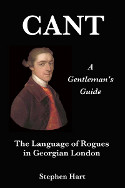THE BOAR'S HEAD TAVERN
This celebrated Shakspearean tavern was situated in Great Eastcheap, and is first mentioned in the time of Richard II.; the scene of the revels of Falstaff and Henry V., when Prince of Wales, in Shakspeare's Henry IV., Part 2. Stow relates a riot in "the cooks' dwellings" here on St. John's eve, 1410, by Princes John and Thomas. The tavern was destroyed in the Great Fire of 1666, but was rebuilt in two years, as attested by a boar's head cut in stone, with the initials of the landlord, I. T., and the date 1668, above the first-floor window. This sign-stone is now in the Guildhall library. The house stood between Small-alley and St. Michael's-lane, and in the rear looked upon St. Michael's churchyard, where was buried a drawer, or waiter, at the tavern, d. 1720: in the church was interred John Rhodoway, "Vintner at the Bore's Head," 1623.
Maitland, in 1739, mentions the Boar's Head, as "the chief tavern in London" under the sign. Goldsmith (Essays), Boswell (Life of Dr. Johnson), and Washington Irving (Sketch-book), have idealized the house as the identical place which Falstaff frequented, forgetting its destruction in the Great Fire. The site of the Boar's Head is very nearly that of the statue of King William IV.
In 1834, Mr. Kempe, F.S.A., exhibited to the Society of Antiquaries a carved oak figure of Sir John Falstaff, in the costume of the 16th century; it had supported an ornamental bracket over one side of the door of the Boar's Head, a figure of Prince Henry sustaining that on the other. The Falstaff was the property of one Shelton, a brazier, whose ancestors had lived in the shop he then occupied in Great Eastcheap, since the Great Fire. He well remembered the last Shakspearean grand dinner-party at the Boar's Head, about 1784: at an earlier party, Mr. Wilberforce was present. A boar's head, with tusks, which had been suspended in a room of the tavern, perhaps the Half-Moon or Pomegranate, (see Henry IV. act ii. sc. 4,) at the Great Fire, fell down with the ruins of the house, and was conveyed to Whitechapel Mount, where, many years after, it was recovered, and identified with its former locality. At a public house, No. 12, Miles-lane, was long preserved a tobacco-box, with a painting of the original Boar's Head Tavern on the lid.[29]
In High-street, Southwark, in the rear of Nos. 25 and 26, was formerly the Boar's Head Inn, part of Sir John Falstolf's benefaction to Magdalen College, Oxford. Sir John was one of the bravest generals in the French wars, under the fourth, fifth, and sixth Henries; but he is not the Falstaff of Shakspeare. In the Reliquię Hearnianę, edited by Dr. Bliss, is the following entry relative to this bequest:—
"1721. June 2.—The reason why they cannot give so good an account of the benefaction of Sir John Fastolf to Magd. Coll. is, because he gave it to the founder, and left it to his management, so that 'tis suppos'd 'twas swallow'd up in his own estate that he settled it upon the college. However, the college knows this, that the Boar's Head in Southwark, which was then an inn, and still retains the name, tho' divided into several tenements (which bring the college about 150l. per ann.), was part of Sir John's gift."
The above property was for many years sublet to the family of the author of the present Work, at the rent of 150l. per annum; the cellar, finely vaulted, and excellent for wine, extended beneath the entire court, consisting of two rows of tenements, and two end houses, with galleries, the entrance being from the High-street. The premises were taken down for the New London Bridge approaches. There was also a noted Boar's Head in Old Fish-street.
Can he forget who has read Goldsmith's nineteenth Essay, his reverie at the Boar's Head?—when, having confabulated with the landlord till long after "the watchman had gone twelve," and suffused in the potency of his wine a mutation in his ideas, of the person of the host into that of Dame Quickly, mistress of the tavern in the days of Sir John, is promptly effected, and the liquor they were drinking seemed shortly converted into sack and sugar. Mrs. Quickly's recital of the history of herself and Doll Tearsheet, whose frailties in the flesh caused their being both sent to the house of correction, charged with having allowed the famed Boar's Head to become a low brothel; her speedy departure to the world of Spirits; and Falstaff's impertinences as affecting Madame Proserpine; are followed by an enumeration of persons who had held tenancy of the house since her time. The last hostess of note was, according to Goldsmith's account, Jane Rouse, who, having unfortunately quarrelled with one of her neighbours, a woman of high repute in the parish for sanctity, but as jealous as Chaucer's Wife of Bath, was by her accused of witchcraft, taken from her own bar, condemned, and executed accordingly!—These were times, indeed, when women could not scold in safety. These and other prudential apophthegms on the part of Dame Quickly, seem to have dissolved Goldsmith's stupor of ideality; on his awaking, the landlord is really the landlord, and not the hostess of a former day, when "Falstaff was in fact an agreeable old fellow, forgetting age, and showing the way to be young at sixty-five. Age, care, wisdom, reflection, begone! I give you to the winds. Let's have t'other bottle. Here's to the memory of Shakspeare, Falstaff, and all the merry men of Eastcheap."[30]
[29] Curiosities of London, p. 265.
[30] Burn's Catalogue of the Beaufoy Tokens.
John Timbs
Club Life of London Vol. II
London, 1866

